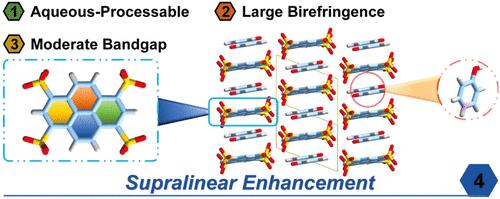Sulfonated Module Aggregation for Ultrahigh Birefringence in Aqueous-Processable Crystals
IF 15.6
1区 化学
Q1 CHEMISTRY, MULTIDISCIPLINARY
引用次数: 0
Abstract
Birefringent crystals play a pivotal role in advanced optics owing to their indispensable function in modulating polarized light. Progress in this field has been driven by the evolution of “material genes”, from small π-conjugated monomers to π-oligomers and ultimately to expanded π-motifs. However, the poor aqueous processability inherent to the hydrophobic nature of extended carbon or C–N skeletons remains a significant hurdle for industrial applications. Herein, we propose a sulfonated module aggregation strategy to simultaneously optimize optical anisotropy and enable aqueous processability. Using a mild evaporation method, we synthesized five 1,3,6,8-pyreneterasulfonate (PTS) salts exhibiting large birefringence values ranging from 0.558 to 0.811 @ 546 nm. Notably, Na2(4-HPyH)2(PTS)·H2O [(4-HPyH) = 4-hydroxypyridinium] combines a wide band gap (Eg = 3.05 eV), enhanced aqueous processability, and a record-high birefringence (Δn = 0.811 @ 546 nm) among all sulfate- and sulfonate-based compounds, establishing it as a highly promising birefringent material. Structurally, the incorporation of [4-HPyH] modules reduces the space available for coordinated and guest water molecules, thereby maximizing the packing density of birefringence-active modules while maintaining ideal alignment of both [4-HPyH] and [PTS] units within the lattice. High-accuracy quantum chemical calculations further reveal a compensation mechanism associated with the ring fusion process─the supralinear polarizability anisotropy effect─which produces a supralinear enhancement of polarizability anisotropy upon aggregation of planar π-modules. This work offers a new paradigm for designing aqueous-processable birefringent crystals and expands the theoretical framework for understanding supralinear enhancement of micro-optical properties via π-module polymerization.

水处理晶体中超高双折射的磺化模聚集
双折射晶体具有调制偏振光的重要作用,在先进光学中起着举足轻重的作用。这一领域的进展是由“物质基因”的进化所推动的,从小π共轭单体到π寡聚体,最终到扩大π基序。然而,延伸碳或碳氮骨架的疏水性所固有的水加工性差仍然是工业应用的一个重大障碍。在此,我们提出了一种磺化模块聚集策略,以同时优化光学各向异性和实现水处理能力。采用温和蒸发法,我们合成了5种1,3,6,8-吡咯酯磺酸盐(PTS),它们的双折射值在0.558 ~ 0.811 @ 546 nm之间。值得注意的是,Na2(4-HPyH)2(PTS)·H2O [(4-HPyH) = 4-羟基吡啶]结合了宽带隙(Eg = 3.05 eV),增强的水性,以及在所有硫酸盐和磺酸基化合物中创纪录的高双折射(Δn = 0.811 @ 546 nm),使其成为一种非常有前途的双折射材料。在结构上,[4-HPyH]模块的结合减少了协调水分子和客体水分子的可用空间,从而最大限度地提高了双折射主动模块的填充密度,同时保持了[4-HPyH]和[PTS]单元在晶格内的理想排列。高精度量子化学计算进一步揭示了与环融合过程相关的补偿机制──超线性极化率各向异性效应──在平面π模聚集时极化率各向异性会产生超线性增强。这项工作为设计可水处理的双折射晶体提供了一个新的范例,并扩展了理解π模聚合对微光学性能的超线性增强的理论框架。
本文章由计算机程序翻译,如有差异,请以英文原文为准。
求助全文
约1分钟内获得全文
求助全文
来源期刊
CiteScore
24.40
自引率
6.00%
发文量
2398
审稿时长
1.6 months
期刊介绍:
The flagship journal of the American Chemical Society, known as the Journal of the American Chemical Society (JACS), has been a prestigious publication since its establishment in 1879. It holds a preeminent position in the field of chemistry and related interdisciplinary sciences. JACS is committed to disseminating cutting-edge research papers, covering a wide range of topics, and encompasses approximately 19,000 pages of Articles, Communications, and Perspectives annually. With a weekly publication frequency, JACS plays a vital role in advancing the field of chemistry by providing essential research.

 求助内容:
求助内容: 应助结果提醒方式:
应助结果提醒方式:


